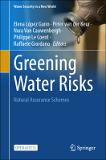Por favor, use este identificador para citar o enlazar a este item:
http://hdl.handle.net/10261/349789COMPARTIR / EXPORTAR:
 SHARE
BASE SHARE
BASE
|
|
| Visualizar otros formatos: MARC | Dublin Core | RDF | ORE | MODS | METS | DIDL | DATACITE | |

| Título: | Multidisciplinary Assessment of Nature-Based Strategies to Address Groundwater Overexploitation and Drought Risk in Medina Del Campo Groundwater Body |
Autor: | Mayor, Beatriz; Hera Portillo, África de la; Llorente Isidro, Miguel; Heredia Díaz, Javier Gustavo; Calatrava, Javier; Martínez Granados, David; Manzano Arellano, Marisol; García Alcaraz, María del Mar; Robles-Arenas, Virginia; Borowiecka, Gosia; Mediavilla, Rosa CSIC ORCID ; Orden Gómez, José Antonio de la; López Gutiérrez, Julio César; Aguilera Alonso, Héctor; Basco Carrera, Laura; Faneca, Marta; Trambauer, Patricia; Hermawan, Tiaravani; Giordano, Raffaele; Gómez, Eulalia; Zorrilla Miras, Pedro; Rica, Marta; Vay, Laura (Madrid); Rubio Sánchez-Aguililla, Félix Manuel; Marín-Lechado, Carlos CSIC ORCID; Ruíz Constán, Ana; Bohoyo, Fernando CSIC ORCID ; Marcos Primo, Carlos; López Gunn, Elena | Fecha de publicación: | 5-may-2023 | Editor: | Springer | Citación: | Greening Water Risks: 201-221 (2023) | Serie: | Water Security in a New World | Resumen: | [EN] Five decades of intensive groundwater exploitation have brought important economic, social and environmental changes in Medina del Campo Groundwater Body (MCGWB). Declining piezometric levels have worsened water quality, increased the costs of water supply and abstraction, and drained connected wetlands and rivers. This chapter presents the different methods and tools developed to assess the impacts and effectiveness for adaptation to droughts of the selected NAS strategies in biophysical, economic and social terms. It follows the methodologies presented in Chaps. 4, 5 and 6. It also summarizes the approaches for integrating all these assessments, as well as the main conclusions and lessons learnt. Important progress has been achieved on understanding and modelling the aquifer-system dynamics and functioning. First, geological and geophysical data analysis, debugging and integration have provided a basis for constructing a set of geological models of the MCGWB. Second, water balance components need to be updated through a deeper analysis of the recharge and groundwater abstractions (pumping). Third, a trend analysis of critical groundwater-related ecosystem services (GRES) and piezometric levels points at groundwater abstraction reductions as the most effective measure for a widespread recovery of the groundwater levels and storage. Fifth, the proposed managed artificial recharge would have limited effects on the recovery of the surface water bodies and no effect on the groundwater bodies. Sixth, the environmental reconstruction from a sedimentary record of the main wetland bed (Lagunas Reales) provides a reference knowledge base to understand the system response to human and climate changes. Finally, different barriers for design and implementation of NAS strategies have been identified and evaluated. Particularly, the lack of effective interaction mechanisms among the different actors involved/interested in the process could play a key role in the future. | Versión del editor: | https://doi.org/10.1007/978-3-031-25308-9_11 | URI: | http://hdl.handle.net/10261/349789 | DOI: | 10.1007/978-3-031-25308-9_11 | ISBN: | 978-3-031-25308-9 |
| Aparece en las colecciones: | (IGME) Libros y partes de libros |
Ficheros en este ítem:
| Fichero | Descripción | Tamaño | Formato | |
|---|---|---|---|---|
| Multidisciplinary Assessment of Nature_2023.pdf | Capítulo | 19,19 MB | Adobe PDF |  Visualizar/Abrir |
CORE Recommender
Page view(s)
12
checked on 27-abr-2024
Download(s)
10
checked on 27-abr-2024
Google ScholarTM
Check
Altmetric
Altmetric
Este item está licenciado bajo una Licencia Creative Commons

